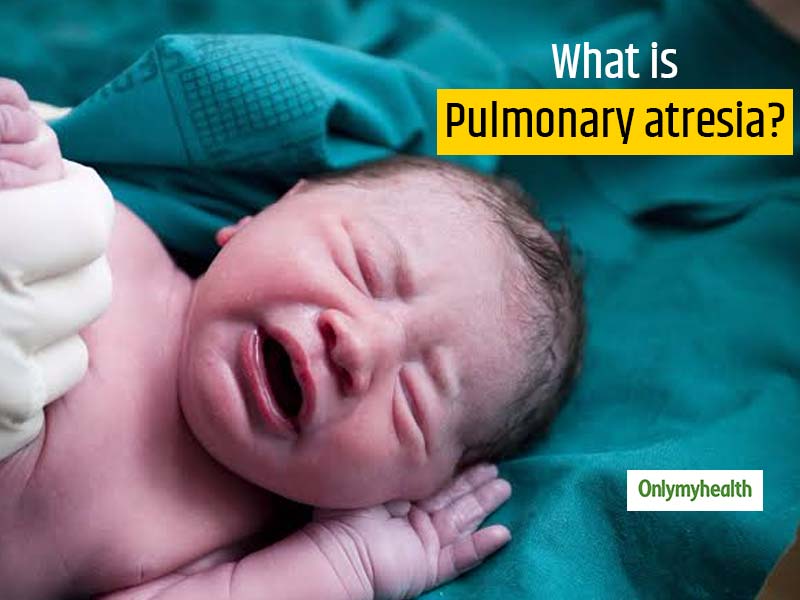
Atresia is a congenital condition in which a passage in the body is closed or missing. There are also some types of atresia namely Aural atresia, biliary atresia, Esophageal atresia, vaginal atresia, Pulmunory atresia, etc. Talking about pulmonary atresia, it is when this heart valve doesn't form at all, and no blood can flow from the right ventricle of the heart to the lungs. This is a very rare condition and only one in fifty thousand babies have this heart defect. Onlymyhealth editorial team spoke to Dr. Amit Bhushan Sharma, Cardiologist, Paras Hospital, Gurgaon about Pulmunory atresia. Therefore, read further to know details about the causes, symptoms and treatment for this condition.
Table of Content:-
Pulmunory Atresia Symptoms
Once that valve is missing, there is no communication between the heart and the lungs. According to Dr Amit Bhushan, This condition of pulmonary atresia is present since birth. It is called as the congenital defect. Congenital defect means presence since birth. So the child will have classical symptoms like:
1# Failure to cry at birth: Normally a child cries at birth. However, this won't be possible if the reason behind it is pulmonary atresia
2# Failure to thrive: In this defect, the child will be very small at first. He/she will be very small for its body weight.

Also Read: Heart Specialist Explains Why Winter Season Increases The Risk of Heart Attack
3# Problem is sucking milk: The baby will also face problems in sucking milk from the mother's breast. This condition can make the baby get tired pretty quickly
4# Colour turns blue: The colour of the baby's nails will become blue. In fact, his lips will also start turning blue in colour. Discoloration of the nails and the extremities will be there in this condition
5# Low oxygen level: If you put in oximeters, like a pulse oximeter, the oxygen levels will be very low in the baby in these cases. This happens because lungs is the place where you clarify your blood. Once there is no communication so there is no purification of blood
Pulmunory Atresia Causes
As mentioned above, it is a congenital heart defect. So, a congenital heart defect means that it's present since birth. The exact cause of this deformity is unknown, but there are measures that a pregnant mother can take to avoid the risk of this condition in the baby. If during pregnancy, the lady has not been following proper precautions, then this defect can be there. The common causes are:
- Taking some medicines which was not supposed to take during pregnancy.
- Smoking during pregnancy
- Alcoholism during pregnancy can also cause this deformity
Consanguineous marriages, that means marriage between first degree relatives can also cause congenital defects. Dr. Amit Bhushan said that it is scientifically proven that consanguineous marriages should not be done because it cause a lot of congenital defects.

Diagnosis Of Pulmunory Atresia
"Proper diagnosis is done by echocardiography. Echocardiography is the ultrasound of the heart in which you can see whether the pulmonary atresia is associated with some hole in the heart or not. If it is associated with the hole in the heart, it is good because then there's at least some communication going on. Otherwise, there's no hole in the heart and the pulmonary valve is also absent, that means there is no communication happening with the lungs. And as a result, child can die as early as first one month of life also."
Pulmunory Atresia Treatment
Dr. Amit Bhushan said, "This condition can be life threatening situation in majority of the kids. So majority of the kids do not survive beyond 2 to 3 years of age until and unless some treatment is done. There is no chance that the baby will survive more than 2 to 3 years, until and unless you do something about it."
- In this case, first thing you see on eco is whether there is any communication present or not. If there is no communication present, then in the first one month, doctors try to create an artificial communication. Artificial communication means that there is a balloon treatment called Balloon Atrial Septostomy (BAS). So, in Balloon Atrial Septostomy, there is a creation of communication so that at least some of the blood goes to the lungs.
- At young age, there is a hole in the heart which is called as PDA. So this hole basically automatically closes within 72 hours of birth. The doctors give some injections like prostaglandins and steroids so that this hole remains open for long. Because this this hole will remain open for long, there will be communication with the lungs.
Also Read: Timely Medical Intervention Could Save the Day for Heart Patients, Says Cardiologist
- Now, the third treatment is that this hole which is there for 72 hours, the doctors need to do some stenting. Like putting stents in adults, so ductal stenting is also done here, so that this hole remains open for some more time. This helps in buying some time to do a major surgery later.
- Open heart surgery can also be done at a later stage, at about two and a half years of age. This surgery's name is Bidirectional Glenn (BDG), also known as the open heart surgery. In this, one basically bypasses the pulmonary valve and creates a direct communication between the inflow and the outflow of the heart. The baby might survive if the first three procedures are done by the cardiologist and then the surgeon can perform the open heart surgery.
Read more on Heart Health
Also watch this video
How we keep this article up to date:
We work with experts and keep a close eye on the latest in health and wellness. Whenever there is a new research or helpful information, we update our articles with accurate and useful advice.
Current Version